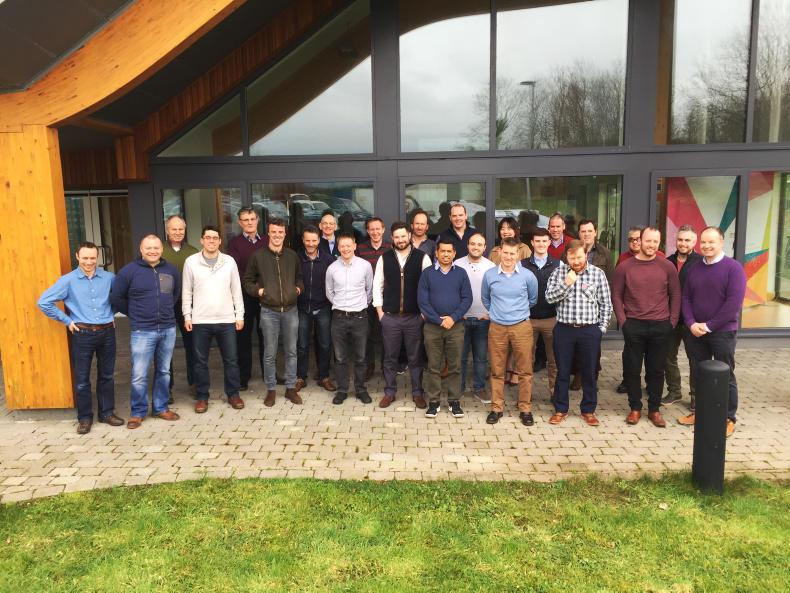Anaerobic digesters (AD) using large volumes of slurry and grass, as foreseen if the technology is to be rolled out across Irish farms, need careful biological management to run efficiently, trainers at a biogas course in Co Fermanagh said last week.
This led several participants to comment that the biogas plants were much like cows.
Michael Köttner, chief executive of the German biogas association IBBK, led the course attended by around 30 farmers and energy professionals at South West College’s CREST centre in Enniskillen and detailed the technologies available for wet AD, running on 12% DM feedstocks, or dry AD for lower moisture materials.

Microbiologist Melanie Hecht, Schaumann Bioenergy at the IBBK biogas training course at the CREST centre, South West College, Enniskillen, Co Fermanagh. \ Thomas Hubert
He and biologist Marco Cuscov from BTS Biogas in Italy insisted on silage quality, with compaction, airtight covering and a smooth cut face essential to avoid parasite bacteria digestion. “Every scratch on the surface is an opportunity for oxygen to come in,” Cuscov warned.
All types of manures, food waste and energy crops can be used in AD. Köttner said that slurry from one dairy cow can generate 289m3 of methane per year on average, while 1t of grass can yield 88m3.
"By volume, cattle slurry has a relatively poor gas yield, but it is “naturally high in methane bacteria and we use it to seed new digesters,” he said. Meanwhile, using “100% grass is very difficult”.
Biologist Melanie Hecht from German consultancy Schaumann Bioenergy explained that poorly managed grass is likely to slow down bacteria activity, and cause overflowing foam and maintenance issues.
“Any feedstock rich in protein or urea will encounter ammonia toxicity, and high sulphur dioxide levels causing corrosion,” she warned.
Think of it as acidosis in cattle. Silage chop length should be 2cm or 4cm. Regular monitoring of pH, temperature and key chemicals with adjustments to feedstocks or use of additives can solve problems.
The course also covered the economics of biogas, with subsidised tariffs for the heat and/or electricity generated from the fuel still essential to make it work.
“We’re ready to go north and south if a tariff comes,” farmer Neal Doherty from Ballymena, Co Antrim, told the Irish Farmers Journal after attending the course.
"After developing his own AD, he is now looking for partners to do it again elsewhere. The main obstacle in his view is the planning system: “It’s very offputting,” he said.
Read more
Watch: 'energy farmers' in Germany
Watch: demo projects set to triple AD numbers in the Republic
Anaerobic digesters (AD) using large volumes of slurry and grass, as foreseen if the technology is to be rolled out across Irish farms, need careful biological management to run efficiently, trainers at a biogas course in Co Fermanagh said last week.
This led several participants to comment that the biogas plants were much like cows.
Michael Köttner, chief executive of the German biogas association IBBK, led the course attended by around 30 farmers and energy professionals at South West College’s CREST centre in Enniskillen and detailed the technologies available for wet AD, running on 12% DM feedstocks, or dry AD for lower moisture materials.

Microbiologist Melanie Hecht, Schaumann Bioenergy at the IBBK biogas training course at the CREST centre, South West College, Enniskillen, Co Fermanagh. \ Thomas Hubert
He and biologist Marco Cuscov from BTS Biogas in Italy insisted on silage quality, with compaction, airtight covering and a smooth cut face essential to avoid parasite bacteria digestion. “Every scratch on the surface is an opportunity for oxygen to come in,” Cuscov warned.
All types of manures, food waste and energy crops can be used in AD. Köttner said that slurry from one dairy cow can generate 289m3 of methane per year on average, while 1t of grass can yield 88m3.
"By volume, cattle slurry has a relatively poor gas yield, but it is “naturally high in methane bacteria and we use it to seed new digesters,” he said. Meanwhile, using “100% grass is very difficult”.
Biologist Melanie Hecht from German consultancy Schaumann Bioenergy explained that poorly managed grass is likely to slow down bacteria activity, and cause overflowing foam and maintenance issues.
“Any feedstock rich in protein or urea will encounter ammonia toxicity, and high sulphur dioxide levels causing corrosion,” she warned.
Think of it as acidosis in cattle. Silage chop length should be 2cm or 4cm. Regular monitoring of pH, temperature and key chemicals with adjustments to feedstocks or use of additives can solve problems.
The course also covered the economics of biogas, with subsidised tariffs for the heat and/or electricity generated from the fuel still essential to make it work.
“We’re ready to go north and south if a tariff comes,” farmer Neal Doherty from Ballymena, Co Antrim, told the Irish Farmers Journal after attending the course.
"After developing his own AD, he is now looking for partners to do it again elsewhere. The main obstacle in his view is the planning system: “It’s very offputting,” he said.
Read more
Watch: 'energy farmers' in Germany
Watch: demo projects set to triple AD numbers in the Republic







 This is a subscriber-only article
This is a subscriber-only article










SHARING OPTIONS: